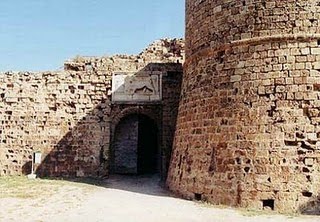The Turks left to collapse one of the 12 most important archaeological sites in the world7:04 pm | Posted by Visaltis
Collapsing the medieval town of Famagusta monument. The Turks are indifferent and left at the mercy of. Revealing Report of the Global Cultural Heritage
Distress signal emitted by the medieval town of Famagusta, according to a report by the GIF (Global Heritage Fund), which reveals h. .. Cypriot newspaper "O Liberal".The medieval town of Famagusta, one, as the report among the 12 most important archaeological sites in the world in danger of collapse.
In the report, writes the newspaper "O Liberal", indicating that the medieval town of Famagusta is located in northern Cyprus, which has been occupied by the Turkish army. The city, says the report has not been officially recognized as a historical monument and archaeological research is needed immediately to preserve what is left and restored what has been destroyed. It stresses that, while international organizations have tried to attract international attention on the need to rescue the city-monument, the "authorities of Northern Cyprus" has shown little interest.
The Report of the GIF entitled "Saving our vanishing heritage" (Save our cultural heritage at risk) has been prepared to attract attention at many archaeological sites around the world with a common feature of their presence inThird World war zones and countries that are on the verge of irreparable destruction due to mismanagement, looting and neglect, conflict and uncontrolled tourism. Among these are Hisham Palace-Palestine, the medieval city of Ani on the border between Turkey and Armenia, the ancient Assyrian capital of Nineveh in Iraq, Kherson Ukraine and others.
Famagusta flourished the Frankish period (1192-1489). It was a city surrounded by strong walls and had the most important port in the Eastern Mediterranean. This became a landmark transit trade between East and West.In 1571, the fall of Famagusta completed the conquest of Cyprus by the Ottomans.Cyprus has been incorporated in the final Ottoman Empire for three centuries remained an obscure province of the Sublime Porte.
Some of the most important monuments of the city: the Gothic Cathedral of St. Nicholas (14th century) architecture mimics the French cathedral city of Reims. In this temple crowned the Frankish kings of Cyprus and Jerusalem. The church was originally decorated with frescoes but destroyed when the Ottomans converted the church into a mosque in 1571. Then it is destroyed and the statues that adorned the temple (eg the statues found in niches of the main entrance and projections of human figures that were life-size windows on the roof of the two towers). Traces of frescoes preserved in the northern wall (St George on horseback) and arch (Crucifixion).
The Church of St. George Greek Orthodox is the largest temple of the Frankish period in Cyprus with dimensions 37.5 x 20.5 m. The construction of the temple located in the second half of the 14th century. Architecturally, the church combines Gothic basilica with a Byzantine dome. The church interior was painted, but with the collapse of the dome of the superstructure and a large section of the north wall of the church, the majority of the murals is not preserved today. Some sections of murals that have survived (the dome of the central apse, the south apse and southern wall) were malicious damage after the events of 1974.
Attached to the south of the church of St. George of the Greeks is a small ruined church dedicated to St. Simeon, which was probably the Orthodox cathedral of Famagusta. The original church probably built in the late 12th century. and belonged to the type of cruciform church with dome.
The great church of St. Peter and Paul was built during the reign of Peter I (1358-1369). It consists of one central and two side aisles. In the east there is a central semi-circular apse and two side chapels. The church combines Byzantine arches with Gothic arches. This temple was not destroyed by the Ottoman cannon attack, then the Cathedral of St. Nicholas was the second temple was converted into a mosque after the Ottoman conquest. During the British domination of the building was used as a granary. The church of St. George of the Latins in the northeastern part of the occupied Famagusta is a fine example of Gothic art with excellent masonry, thoughtful and simple volume ratios. Today the church is kept in dilapidated condition and saved only the north wall, the three-sided arch and a portion of the south wall has been restored.
The Royal Palace (Ralazzo del Rroveditore) is located in the town of Famagusta, opposite the Cathedral of St. Nicholas. This building was probably originally the Lusignan palace built in the 13th century. In the Venetian domination the building became the official residence of the Venetian Rroveditori (Captain). With the siege of Famagusta by the Ottoman palace was badly damaged by cannon and ended up ruined.
The medieval town of Famagusta walls surrounding possible with 15 bastions and other fortifications that a perimeter of about 3.5 km and an average of 15 m. The entire city was surrounded by a deep ditch filled with seawater. The walls and fortifications were strengthened by the Venetians, particularly during the period 1540 - 1570 when he was no longer expected to attack the Ottomans. Some of the most important parts of the fortifications is the Othello tower above the gate of which is a marble plaque with the Venice Lion winged.
The castle is surrounded by a moat and is isolated from other fortifications. In the main hall there are the arms of the kingdom of Jerusalem. From the castle began breakwater that protected the harbor. Martinengo Bastion (Martinengo) is one of the finest examples of military architecture. The Portal Thalasssas (Rorta delMare) was built in 1496 by Nicholas Priolo (Nicolao Rrioli), one of the Venetian generals of Famagusta. The entrance is decorated with a marble slab with winged lion, symbol of Venice.
Labels
Architecture
(95)
Art
(24)
Music+video
(19)
Politic
(18)
Archeology
(15)
Wonder
(13)
Energy
(6)
Strange Architecture
(6)
conspiracy
(6)
Design Art
(4)
Mystery
(4)
Ecology
(2)
Antropology
(1)
MY CITY
(1)

Architecture.!!
The refusal of the regularity or the acceptance of the unorthodox.
It is the art of everything. In the inanimate and living. The shape and meaning,
Architecture.!!
In spirit and body, logic and absurdity.
Everything is architecture. By Hermes Trismegistus, by bacterium.
The Heraclitus said ... Everything flows ....
The Architecture says .... everything in shape ..... so have art in them ..!!
The refusal of the regularity or the acceptance of the unorthodox.
It is the art of everything. In the inanimate and living. The shape and meaning,
Architecture.!!
In spirit and body, logic and absurdity.
Everything is architecture. By Hermes Trismegistus, by bacterium.
The Heraclitus said ... Everything flows ....
The Architecture says .... everything in shape ..... so have art in them ..!!
Michael Balaroutsos
architect
Saturday, October 30, 2010
Famagusta.The Turks left to collapse one of the 12 most important archaeological sites in the world
Subscribe to:
Post Comments (Atom)



1 σχόλια:
Beneficial info and excellent design you got here! I want to thank you for sharing your ideas and putting the time into the stuff you publish! Great work!
Post a Comment